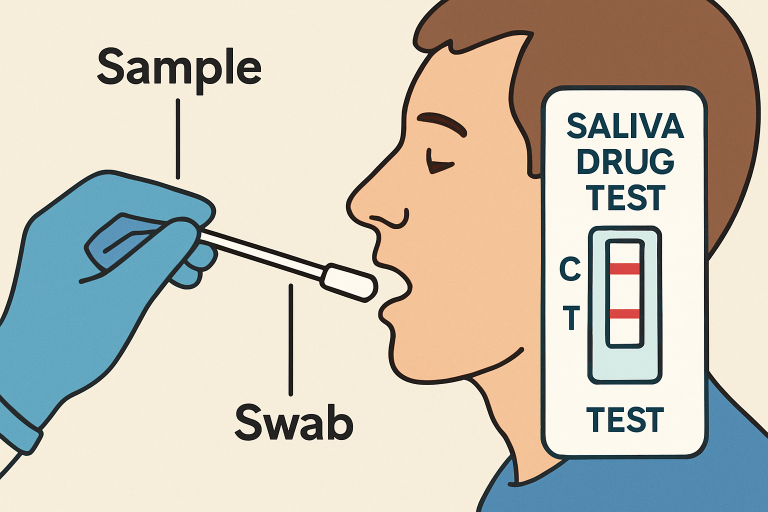The role of saliva testing in cocaine detection: A detailed overview
Table of Contents
- Introduction to Saliva Testing for Cocaine Detection
- Mechanism of Cocaine Detection in Saliva
- Advantages of Saliva Testing Over Other Methods
- Challenges and Limitations
- Applications in Various Sectors
- Recent Developments in Saliva Testing Technology
- Legal and Ethical Considerations
- Conclusion
Introduction to saliva testing for cocaine detection
Saliva testing is transforming the landscape of drug detection, particularly for substances like cocaine. Non-invasive, discreet, and highly accessible, saliva testing delivers results quickly, making it an attractive option for both organizations and individuals. Employers, healthcare providers, and law enforcement agencies are increasingly adopting this approach due to its practicality and accuracy.
A cocaine oral fluid test, for example, allows for rapid detection of recent use without the need for more invasive procedures like blood draws. This type of testing is particularly valuable in workplace or roadside scenarios where immediate results are critical for safety and compliance.
Unlike traditional blood or urine testing, saliva testing can often be administered on the spot, requiring minimal privacy concerns or specialized settings. This revolution in drug detection helps ensure timely intervention and enhances public and workplace safety.
Mechanism of cocaine detection in saliva
When cocaine is ingested, it is absorbed into the bloodstream and subsequently secreted into bodily fluids, including saliva. Saliva acts as a reliable matrix for cocaine detection as the substance and its metabolites are present in measurable concentrations shortly after use. Generally, cocaine is detectable in saliva for up to 24 hours after use, allowing identification of recent drug activity.
The exact detection window, however, can be influenced by factors such as method of use, individual metabolism, and the amount of cocaine consumed. According to US News, saliva testing provides a brief but effective window to identify recent drug exposure, enabling authorities to respond swiftly.
Saliva-based testing is convenient and non-invasive, making it suitable for various settings, including workplaces and clinical environments. Its rapid results help ensure timely interventions and informed decision-making when recent drug use is suspected.
Advantages of saliva testing over other methods
- Non-Invasive Collection: One of the standout benefits of saliva testing is the collection process. Saliva samples can be obtained painlessly, quickly, and with minimal specialized equipment, thereby reducing potential discomfort or invasiveness for the test subject.
- Reduced Tampering Risk: Sample collection is frequently observed by staff, making it challenging to adulterate or substitute the specimen compared to urine or hair testing.
- Rapid Results: Many saliva tests can deliver preliminary results within minutes, streamlining decision-making in urgent situations.
These advantages contribute to the popularity of saliva testing in sectors where immediate and reliable drug detection is critical.

Challenges and limitations
Despite its many benefits, saliva testing is not without drawbacks.
- Short Detection Window: Cocaine remains detectable in saliva for a much shorter period compared to other methods, such as urine or hair testing. This limits its utility for identifying past, rather than recent, drug use.
- Environmental Contamination: Recent use of cocaine, especially through oral administration, can sometimes result in false positives due to unabsorbed drug contaminating the mouth.
- Variability in Saliva Composition: Individual factors, such as hydration levels, oral hygiene, and the presence of certain foods or drinks, can influence test results and may contribute to inconsistent outcomes.
Applications in various sectors
Saliva testing is extensively used in multiple professional settings:
- Workplace Testing: Employers rely on saliva testing to maintain safety, compliance, and productivity. Quick turnaround helps minimize workplace disruption and supports swift action when drug use is detected. According to the Department of Labor, many organizations also implement preventive programs to reduce substance use before it becomes a workplace issue.
- Law Enforcement: Roadside testing using oral fluid is a common approach to curb impaired driving and identify recent drug use among motorists.
- Healthcare: In emergency rooms and clinics, rapid saliva-based tests enable healthcare professionals to make timely and accurate clinical decisions regarding patient treatment and safety.
Recent developments in saliva testing technology
Technological progress continues to enhance the capabilities of saliva-based drug tests. Modern devices incorporate advanced immunoassay techniques that enhance the sensitivity and specificity of cocaine detection, enabling more accurate results and reducing the incidence of false positives.
The introduction of dried oral fluid spot methods enables the simultaneous detection of multiple substances, simplifying logistics for organizations that need comprehensive screening. Many of today’s devices are compact, portable, and connect easily with digital reporting systems, streamlining the entire process from collection to result reporting.
Legal and ethical considerations
The application of saliva testing raises important legal and ethical questions, particularly regarding employee and individual privacy, informed consent, and data handling. Regulatory environments differ by jurisdiction, underscoring the need for organizations to comply with local and national guidelines. Transparent procedures, clear communication, and consistent protocols are essential to upholding individuals’ rights and maintaining trust in the testing process.
Saliva-based drug testing is a robust and effective tool
Saliva testing has established itself as a cornerstone of modern cocaine detection strategies. Its blend of convenience, accuracy, and speed makes it invaluable for employers, law enforcement, and healthcare providers alike.
While it is not without its limitations, continuing innovation in technology, along with careful attention to ethical and legal standards, ensures that saliva-based drug testing remains a robust and effective tool in promoting safety and well-being.




